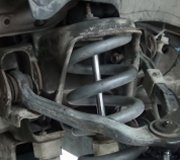The most common cause of repeat wheel bearing failures is improper installation procedures. Specifically, the bearing is held together with the outer CV joint and axle nut. Ne vehicle weight must ever be placed on the bearing unless the axle nut is torqued to spec. That value is very high and must be set with a click-type torque wrench. The lowest spec I have ever run into is 180 foot pounds, but some go as high as 240 foot pounds.
Some people install the wheel/tire and set the tire on the ground to keep the axle shaft from turning so they can tighten the nut, but by that time the damage has been done. An easier way is to just drop a punch into one of the cooling slots in the brake rotor.
To verify a new bearing is noisy, I prefer to raise the car on a hoist, run the engine in gear, then listen next to each one with a stethoscope. You can also raise the front tires off the ground, shift the neutral, reach over one of the tires and wrap your fingertips lightly around the coil spring, then rotate the tire by hand. If the bearing is noisy, you will feel the vibration/roughness in the spring.
Tuesday, February 6th, 2018 AT 1:23 PM


